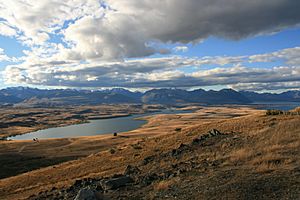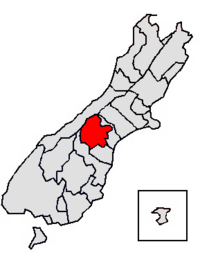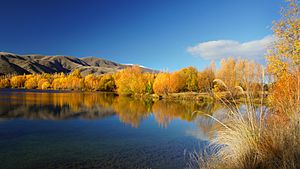Mackenzie District facts for kids
Quick facts for kids
Mackenzie District
|
|
|---|---|
|
Territorial authority district
|
|
 |
|

Mackenzie District within the South Island
|
|
| Country | New Zealand |
| Island | South Island |
| Region | Canterbury |
| Communities |
|
| Wards |
|
| Formed | 1989 |
| Seat | Fairlie |
| Area | |
| • Total | 7,339.23 km2 (2,833.69 sq mi) |
| • Land | 7,138.59 km2 (2,756.23 sq mi) |
| Population
(June 2023)
|
|
| • Total | 5,690 |
| • Density | 0.7753/km2 (2.0080/sq mi) |
| Postcode(s) |
Map of postcodes
|
Mackenzie District is a local government district on New Zealand's South Island, administered by the Mackenzie District Council. It is part of the larger Canterbury Region. The region takes its name from the Mackenzie Basin, an elliptical intermontane basin which covers much of inland Canterbury.
Contents
Geography
Principal settlements
The Mackenzie District has four major settlements:
- Fairlie (pop. 950) – seat of the district
- Mount Cook Village (pop. 200)
- Twizel (pop. 1,850) – the district's largest town
- Lake Tekapo (pop. 720)
Other smaller settlements include:
Geographical features
Rivers:
- Mackenzie River
- Tekapo River
- Pukaki River
- Grays River
Mountains:
Lakes:
- Lake Tekapo and the 'Church of the Good Shepherd'.
- Lake Pukaki
- Lake Ruataniwha, one of New Zealand's main rowing venues
- Lake Ōhau
Glaciers:
- Tasman Glacier
- Hooker Glacier
Skifields:
- Fox Peak
- Mt Dobson
- Round Hill
- Tasman Glacier Heliski
National parks:
- Aoraki / Mount Cook National Park
Other features:
- Mackenzie Basin
- Aoraki Mackenzie Dark Sky Reserve
Climate
The Mackenzie District has a dry temperate-continental climate with clear, crisp snowy winters and long, hot summers. Autumn is known for being a riot of colour, while spring brings wildflowers blooming throughout the region, including lupins. The warm summer season is from November to February, with temperatures often passing 30 degrees. In the cooler winter season, from June to September, temperatures drop to below 0 degrees Celsius overnight, while sunny winter days average around 8 degrees and regular snowfall.
History
The Mackenzie Basin was named in the 1850s by and after James Mckenzie, a Scottish-origin shepherd and sheep thief, and the name transferred to the modern district.
Demographics
Mackenzie District covers a land area of 7,138.59 km2 (2,756.23 sq mi) and had an estimated population of 5,690 as of June 2023, with a population density of 0.80 people per km2.
| Ethnicity | Population |
|---|---|
| New Zealand European |
4,323
|
| Māori |
447
|
| Pasifika |
75
|
| Asian |
459
|
| MELAA |
108
|
| Other |
81
|
| Historical population | ||
|---|---|---|
| Year | Pop. | ±% p.a. |
| 2006 | 3,801 | — |
| 2013 | 4,158 | +1.29% |
| 2018 | 4,866 | +3.19% |
| 2023 | 5,115 | +1.00% |
Mackenzie District had a population of 5,115 in the 2023 New Zealand census, an increase of 249 people (5.1%) since the 2018 census, and an increase of 957 people (23.0%) since the 2013 census. There were 4,437 dwellings. The median age was 41.1 years (compared with 38.1 years nationally). There were 831 people (16.2%) aged under 15 years, 885 (17.3%) aged 15 to 29, 2,457 (48.0%) aged 30 to 64, and 942 (18.4%) aged 65 or older.
Ethnicities were 84.5% European/Pākehā, 8.7% Māori, 1.5% Pasifika, 9.0% Asian, 2.1% Middle Eastern, Latin American and African New Zealanders, and 1.6% other. People may identify with more than one ethnicity.
Mackenzie District had a population of 4,866 at the 2018 New Zealand census. There were 1,863 households, comprising 2,511 males and 2,352 females, giving a sex ratio of 1.07 males per female.
The percentage of people born overseas was 24.5, compared with 27.1% nationally.
Although some people chose not to answer the census's question about religious affiliation, 51.7% had no religion, 37.1% were Christian, 0.2% had Māori religious beliefs, 1.1% were Hindu, 0.2% were Muslim, 1.2% were Buddhist and 1.3% had other religions.
Of those at least 15 years old, 777 (19.1%) people had a bachelor's or higher degree, and 702 (17.3%) people had no formal qualifications. The median income was $33,400, compared with $31,800 nationally. 555 people (13.7%) earned over $70,000 compared to 17.2% nationally. The employment status of those at least 15 was that 2,451 (60.3%) people were employed full-time, 660 (16.2%) were part-time, and 30 (0.7%) were unemployed.
| Name | Area (km2) | Population | Density (per km2) | Households | Median age | Median income |
|---|---|---|---|---|---|---|
| Pukaki Ward | 5,155.26 | 2,634 | 0.51 | 981 | 38.2 years | $34,500 |
| Opuha Ward | 1,983.34 | 2,229 | 1.12 | 879 | 42.8 years | $31,500 |
| New Zealand | 37.4 years | $31,800 |
| SA2 name | Population | Dwellings | Median age | Median income |
|---|---|---|---|---|
| Fairlie | 885 | 480 | 47.3 years | $25,700 |
| Mackenzie Lakes | 1,182 | 984 | 31.8 years | $36,500 |
| Opua | 1,347 | 639 | 40.0 years | $36,600 |
| Twizel | 1,455 | 1,485 | 46.5 years | $31,400 |
Economy
In 2012, the Mackenzie District had 850 businesses who employed 1900 full time equivalent staff and generated $190 million dollars in revenue. The economy is based on hydroelectric generation, farming (including aquaculture) and tourism.
Of the 267 farms in the Mackenzie District in 2012, 34% of these were sheep farms, 18% sheep and beef cattle, and 15% beef cattle. Minimal amounts of crop farming occurs in the Mackenzie District, with small amounts of barley (7,733 tonnes) and oats (2,265 tonnes) grown.
A relatively sparsely settled area, the district does have a wide number of farms. However, in the late 2000s, numerous proposals for new farming operations have locals fearing that the agriculture will be transformed from often family-held farms to large agribusiness operations, causing increased local ecologic damage and siphoning off capital overseas.
List of mayors
| Name | Term of office |
|---|---|
| Bruce Scott | 1989-1992 reference to follow |
| Neil Anderson | 1992–2001 |
| Stan Scorringe | 2001–2004 |
| John O'Neill | 2004–2010 |
| Claire Barlow | 2010–2016 |
| Graham Smith | 2016–2022 |
| Anne Munro | 2022–present |


